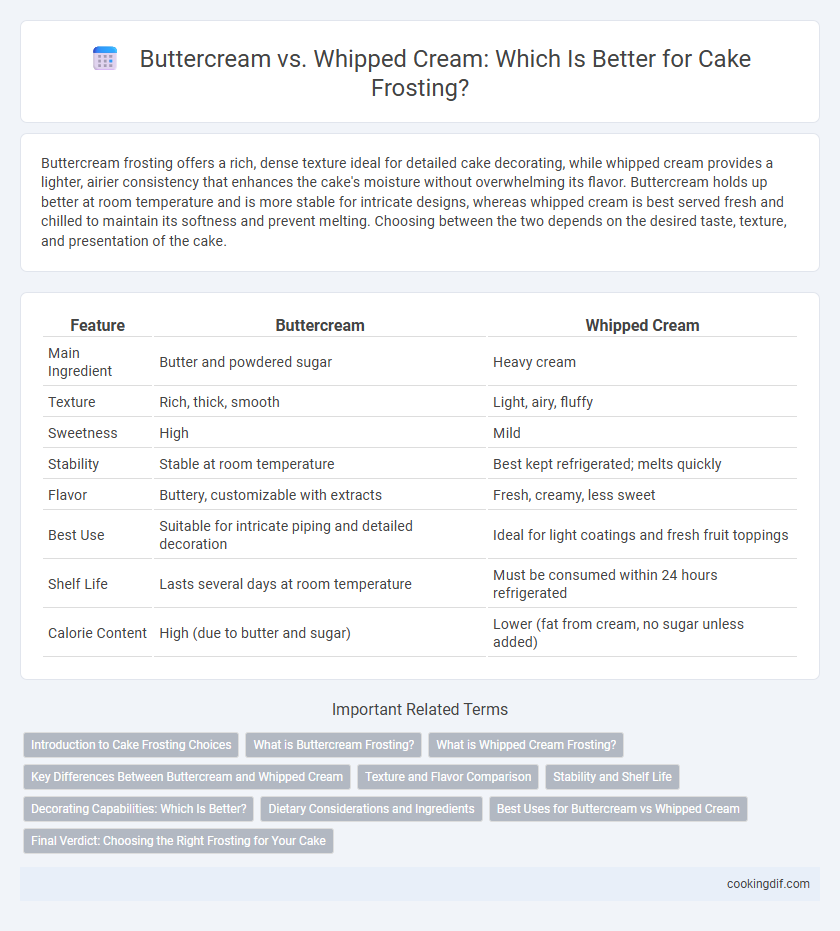Buttercream frosting offers a rich, dense texture ideal for detailed cake decorating, while whipped cream provides a lighter, airier consistency that enhances the cake's moisture without overwhelming its flavor. Buttercream holds up better at room temperature and is more stable for intricate designs, whereas whipped cream is best served fresh and chilled to maintain its softness and prevent melting. Choosing between the two depends on the desired taste, texture, and presentation of the cake.
Table of Comparison
| Feature | Buttercream | Whipped Cream |
|---|---|---|
| Main Ingredient | Butter and powdered sugar | Heavy cream |
| Texture | Rich, thick, smooth | Light, airy, fluffy |
| Sweetness | High | Mild |
| Stability | Stable at room temperature | Best kept refrigerated; melts quickly |
| Flavor | Buttery, customizable with extracts | Fresh, creamy, less sweet |
| Best Use | Suitable for intricate piping and detailed decoration | Ideal for light coatings and fresh fruit toppings |
| Shelf Life | Lasts several days at room temperature | Must be consumed within 24 hours refrigerated |
| Calorie Content | High (due to butter and sugar) | Lower (fat from cream, no sugar unless added) |
Introduction to Cake Frosting Choices
Buttercream frosting, made from butter and powdered sugar, offers a rich, creamy texture ideal for detailed cake decoration and long-lasting stability at room temperature. Whipped cream frosting is lighter and fluffier, created by whipping heavy cream and sugar, providing a fresh, airy finish best suited for chilled cakes and delicate flavors. Choosing between buttercream and whipped cream depends on the desired texture, flavor intensity, and storage conditions of your cake.
What is Buttercream Frosting?
Buttercream frosting is a rich and creamy icing made primarily from butter and powdered sugar, often combined with milk or cream to achieve a smooth texture. This frosting is favored for its stability, allowing it to hold intricate designs and maintain shape at room temperature. Its dense, velvety consistency makes it ideal for decorating cakes and providing a sweet, buttery flavor that enhances dessert layers.
What is Whipped Cream Frosting?
Whipped cream frosting is a light, airy topping made by whipping heavy cream with sugar and vanilla until soft peaks form, creating a delicate texture ideal for cakes and pastries. This frosting offers a less sweet, creamy alternative to traditional buttercream, emphasizing freshness and a melt-in-the-mouth feel. Due to its high moisture content, whipped cream frosting requires refrigeration and is best used on cakes meant to be served shortly after frosting.
Key Differences Between Buttercream and Whipped Cream
Buttercream frosting contains a higher fat content due to its primary ingredient, butter, creating a dense and rich texture ideal for detailed piping and stable decorations. Whipped cream frosting, made by whipping heavy cream with sugar, is lighter and airier but less stable, often requiring refrigeration and quick consumption to maintain its shape. Buttercream tends to be sweeter and more versatile for flavor infusions, while whipped cream frosting offers a delicate, fresh taste with lower sweetness.
Texture and Flavor Comparison
Buttercream frosting offers a rich, creamy texture with a dense, smooth consistency ideal for detailed decorating, while whipped cream frosting provides a light, airy texture that melts easily on the tongue. Flavor-wise, buttercream delivers a sweet, buttery taste often enhanced with vanilla or chocolate, whereas whipped cream offers a subtle, fresh dairy flavor with a mild sweetness. Choosing between them depends on desired texture intensity and flavor richness for the cake.
Stability and Shelf Life
Buttercream frosting offers superior stability and a longer shelf life compared to whipped cream, making it ideal for cakes that need to be stored or transported. Buttercream's high fat content helps it maintain structure at room temperature and prevents it from melting quickly. In contrast, whipped cream has a lighter texture but is less stable and prone to deflation and spoilage within a day or two, requiring refrigeration and quick consumption.
Decorating Capabilities: Which Is Better?
Buttercream offers superior decorating capabilities due to its dense, stable texture that holds intricate designs and sharp edges, making it ideal for detailed piping and sculpting. Whipped cream, while lighter and fluffier, tends to lose shape quickly and is less suited for complex decorations, especially in warmer environments. For professional cake decorators seeking precision and longevity in frosting, buttercream is the preferred choice.
Dietary Considerations and Ingredients
Buttercream frosting is rich in butter and powdered sugar, offering a denser texture and higher calorie content, which may impact those monitoring fat and sugar intake. Whipped cream frosting is lighter, made primarily from heavy cream and sugar, making it a lower-fat, dairy-based option suitable for those seeking a less sweet or less caloric alternative. Both frostings contain dairy, so they are not suitable for vegan or lactose-intolerant diets without substitutions.
Best Uses for Buttercream vs Whipped Cream
Buttercream frosting, made from butter and sugar, is best for detailed cake decorating and holds up well in warm conditions, making it ideal for tiered cakes and intricate piping designs. Whipped cream frosting, lighter and less sweet, excels on simple cakes and fresh fruit desserts but requires refrigeration and is not suitable for warm, humid environments. Choosing between buttercream and whipped cream depends on texture preference, decoration complexity, and storage conditions.
Final Verdict: Choosing the Right Frosting for Your Cake
Buttercream frosting offers a richer, denser texture with a sweeter, buttery flavor ideal for detailed decorating and longer shelf life, while whipped cream frosting provides a light, airy consistency with a fresh, less sugary taste perfect for delicate, short-lived cakes. The choice depends on desired cake stability, flavor profile, and occasion; buttercream excels in structure and durability, whereas whipped cream enhances moisture and softness. For formal events or cakes requiring intricate designs, buttercream is preferred, while whipped cream suits casual gatherings and cakes meant to be consumed quickly.
Buttercream vs Whipped Cream for frosting Infographic

 cookingdif.com
cookingdif.com